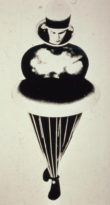.
I’ve posted about Hannes Meyer several times already. For those who don’t know, Meyer was the second Bauhaus director. He stepped in after Walter Gropius returned to his own private practice in 1928, and presided over the art and architecture school until he was forced out due to his Marxist convictions in 1930. Ludwig Mies van der Rohe replaced him. After his tenure came to an abrupt end, Meyer and a number of his students traveled to Moscow at the invitation of the Soviet government. Despite his enthusiastic support for the five-year plans then underway, and his unwavering loyalty throughout, Meyer eventually wore out his welcome in the USSR. Several of his colleagues were rounded up and arrested before he finally decided to return to Switzerland. Meyer didn’t stay long there, however, moving permanently to Mexico in 1938.
Today he is largely forgotten, though some have expressed interest in his legacy of late. Claude Schnaidt has provided probably the best comprehensive account of his work. It is not surprising that Meyer would be overshadowed by his predecessor Gropius on the one hand, and his successor Mies on the other. Both were more significant in the history of modern architecture, more groundbreaking or talented. Nevertheless, Meyer was quite innovative himself, as can be seen from his designs for co-ops and proposal for the League of Nations building in Geneva (1926). His skill in other media, such as photography and city planning, was also considerable.
Yesterday I discovered a rare article Meyer wrote in 1942, originally in Spanish, on the architectural profession in the Soviet Union. It was translated into English and published by Harvard’s student design magazine TASK in 1943. The article is interesting in several respects. First, because it displays no bitterness whatsoever at the Stalinist regime that forced Meyer into exile and many of his friends. Second, because the pioneering modernist implicitly repudiates many of his earlier positions on the role of architecture in modern society, criticizing the avant-garde architects at VKhUTEMAS and providing a “dialectical” justification for protopostmodernist eclecticism. Third, because it includes a number of facts and figures, which are interesting even though they are without a doubt inaccurate or misleading.
Alongside the article, which appears below, I’ve included a bunch of photos Meyer took documenting his journeys across the USSR. Enjoy.
The Soviet architect
Hannes Meyer
TASK magazine
February 1943
.
.
I dedicate this unpretentious work to the composer Dmitri Shostakovitch, who, in the trenches of Leningrad, December 1941, put the final notes on his Seventh Symphony, rising in this classic form — score and weapon forged in hand — to the present duty of all democratic intellectuals in the entire world: the defense of our culture and of humanity.
Hannes Meyer
Mexico 11/15/1942
Villalongin 46-8
.
The architect has always been intimately linked with his social environment. He is one of the human tools that serve the ruling power to fortify its position. Architecture besides its direct utility, has always served to maintain power. We find an architect serving the Pope, in Bramante, or the King, in Le Nôtre, or as a colonial functionary, in Tolsa, or as a privileged member of the bourgeoisie, in Tony Garnier. To this we must add that building’ is an activity profoundly connected with social-economic needs and the superimposed spiritual structure. And the architect is always of necessity a collaborator. He does his work together with economists and industrialists, with workers, artisans, and housewives. In Hindu tradition the future architect must first perfect himself as a carpenter, a mason, a painter, a sculptor, and an iron worker. Mature men of forty years are then known as “masters of architecture.”
In capitalist society architecture is numbered among the “liberal professions,” and this is why bankers, speculators, and other knights of the stock market can use the decorative cloak of architecture to cover the sores of the social body. — Architecture is not an autonomous art, as certain prima donnas of the drawing board would like to have us believe. The architect is born and finds his form in the womb of his society and is brought forth by a specific age and by a definite epoch. Hence we find the most capable and creative architects in the heart of the classical forms of society.
I
.
The socialist society in the USSR, created by the October Revolution of 1917, is an experiment without precedent. For the first time in human history the people themselves own the factories and all the means of production. The land also has been nationalized. Private economy, until then in a state of anarchy, has been transformed into a planned and directed economy. Together with the great change in the position of intellectuals in the USSR, the position and the role of the architect has been completely altered. The architectural structure of the new state has itself been transformed.
Outside of the USSR it is very hard to form any clear idea of the present conception of architecture in that country. It is confusing to find in its publications buildings of the most diverse character, examples of classicism, and of conflicting trends. These efforts in search of a national ideal are described as backward by American architects, who are justly proud of their highly industrialized achievements. They describe the Soviet attempt to connect by way of dialectics the magnificent past of Russian architecture with the dynamic present as a new academicism. Because of their ignorance of social and economical matters, they can employ no other pattern than those found in their everyday surroundings. For this reason “glass construction,” which is the last word on this continent, over there, in a different environment appears completely out of place. Chippendale furniture, here an expression of conservatism, is there a step forward in the development of the highest quality in cabinet work.


































































































































